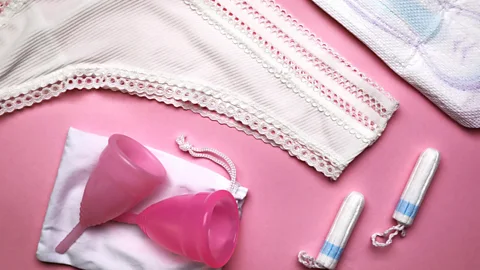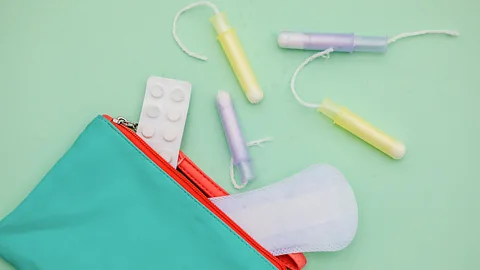Pads, pants or cups: Which period product is the most climate-friendly?
 Getty Images
Getty ImagesTwenty billion disposable menstrual products are discarded each year in the US. There's a huge array of reusable options, from pads to pants to menstrual cups. Ana Santi explores which is the most sustainable and how safe they are.
During a weekend away with my girlfriends a few years ago, one of them mentioned that she was wearing period pants, an environmental decision to move away from single-use pads and tampons. I'd vaguely heard of them, but didn't know anyone who wore them and I'd always been a little sceptical – would they be absorbent enough? My friend convinced me otherwise and they've remained my product of choice ever since. But as I browse the shelves of menstrual products in my local supermarket today, I'm overwhelmed by the choice available: so many pads and tampons (some organic, most not), numerous types of cups, a few period pants.
And still, 49 billion single-use period products are used every year in Europe alone. In the US, it's about 20 billion discarded each year, generating 240,000 tonnes of solid waste. Globally, disposable sanitary pads – which can contain up to 90% plastic and end up largely in landfill – are the most commonly used menstrual product.
I set out to find the most sustainable period product available.
Given that 1.8 billion people across the world menstruate every month, a group of academics based in and the US conducted a life-cycle assessment of menstrual products across four product groups: disposable non-organic and organic pads and tampons (with applicators); reusable pads; period underwear; and menstrual cups, which are made from soft, flexible silicone or rubber and can hold 20-30ml (around two tablespoons) of menstrual blood. Comparing eight environmental impact indicators – global warming potential, fossil resources, land use, water use, carcinogenic effects, ecotoxicity, acidification and eutrophication – and conducted over one year across three countries (, India and the US), the assessment considers impacts from production to disposal.
Across all the three countries and environmental impacts, the menstrual cup was a clear winner, followed by period underwear, reusable pads and, in last place, single-use pads and tampons. Small and lightweight, one person's menstrual cup can last up to 10 years.
Disposable pads – both organic and non-organic – had the highest impacts across all eight categories except water use, with non-organic pads scoring the highest for global warming potential and resource depletion. The global warming potential – greenhouse gas emissions' ability to absorb heat and warm the atmosphere over a given time period – came from manufacturing, with almost half of the impact from production of polyethylene (a petroleum-based plastic). But one of the most surprising results – not least to the report's authors – was that organic cotton pads had the highest impact of all, across five categories.
"The impacts are mostly linked to raw material manufacturing and organic production, which can have higher environmental impacts," explains Mélanie Douziech, one of the study's co-authors from Mines Paris-PSL university. The yield of organic farming is lower than conventional farming, meaning more water and land is needed to produce the same amount of organic as conventional cotton. Similar results were found for organic and non-organic cotton tampons.
 Getty Images
Getty ImagesDepending on the product, different parts of the lifecycle influence the emissions. "For disposable products, it's the raw material production and manufacturing, as a lot of these products have plastics in them, which have quite a large global warming impact," says Douziech. "With reusable products, it is the manufacturing and use phases, especially the electricity requirements."
Water and electricity are needed to wash all reusable products between wear, but period pants perform better than reusable pads, in part because otherwise another form of underwear would be worn – and washed – regardless. "Even though the menstrual cup is a clear winner, period underwear is also an alternative product that really reduces the environmental impacts," says Douziech. How we care for them can also affect the overall impact, such as washing at lower temperatures and as part of a full load.
The assessment did not consider plastic pollution, but according to the study each conventional pad, including wrappers, wings and adhesives, adds some 2g of non-biodegradable plastic – the equivalent of four plastic bags – to the environment and take an estimated 500 to 800 years to decompose. The study adds that, in the US, 80% of conventional tampons and 20% of conventional pads are flushed down toilets, blocking sewers and releasing microplastics into oceans.
Prior to this report, an analysis of several life-cycle analyses comparing the environmental impacts of menstrual products, including emissions and resource depletion, was commissioned by the UN Environment Programme in 2021. Co-author Philippa Notten, director of the Cape Town-based non-profit TGH Think Space, which focuses on energy, climate change and sustainability projects, says that, due to a lack of data, the impact of plastic at menstrual products' end of life is not well documented in life-cycle assessments. "Plastic tends to get modelled as if it ends up in a landfill or incinerator. Counterintuitively, landfill actually looks good from a carbon footprint point of view because plastic takes hundreds of years to degrade, so those carbon emissions are locked up in the landfill, which acts like a carbon sink," she says. "In reality, the product doesn't always end up in a formal waste management stream; it ends up as litter on beaches, as microplastics in the sea. And there is still a lot of carbon in the production of plastics."
More like this:
• Seven proven ways to help the planet in 2025
In UNEP's report, the menstrual cup also comes out on top by a considerable margin. "It's quite rare for this to happen to a product," Notten says. "It's not that the cup doesn't have a carbon footprint, but because it's such a small, light product, the impact is also small relative to other products."
"We always talk about 'break even points' in these studies: how many times do you have to use a renewable product before it has made up for the emissions caused in its manufacturing and use phases, compared to a single-use product">window._taboola = window._taboola || []; _taboola.push({ mode: 'alternating-thumbnails-a', container: 'taboola-below-article', placement: 'Below Article', target_type: 'mix' });
